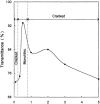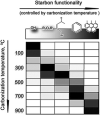The effect of synthesis conditions and process parameters on aerogel properties
- PMID: 37937209
- PMCID: PMC10627014
- DOI: 10.3389/fchem.2023.1294520
The effect of synthesis conditions and process parameters on aerogel properties
Abstract
Aerogels are remarkable nanoporous materials with unique properties such as low density, high porosity, high specific surface area, and interconnected pore networks. In addition, their ability to be synthesized from various precursors such as inorganics, organics, or hybrid, and the tunability of their properties make them very attractive for many applications such as adsorption, thermal insulation, catalysts, tissue engineering, and drug delivery. The physical and chemical properties and pore structure of aerogels are crucial in determining their application areas. Moreover, it is possible to tailor the aerogel properties to meet the specific requirements of each application. This review presents a comprehensive review of synthesis conditions and process parameters in tailoring aerogel properties. The effective parameters from the dissolution of the precursor step to the supercritical drying step, including the carbonization process for carbon aerogels, are investigated from the studies reported in the literature.
Keywords: aerogel; aging; carbon; polysaccharide; silica; sol-gel; solvent exchange; supercritical.
Copyright © 2023 Payanda Konuk, Alsuhile, Yousefzadeh, Ulker, Bozbag, García-González, Smirnova and Erkey.
Conflict of interest statement
The authors declare that the research was conducted in the absence of any commercial or financial relationships that could be construed as a potential conflict of interest.
Figures










Similar articles
-
Aerogels in Chemical Engineering: Strategies Toward Tailor-Made Aerogels.Annu Rev Chem Biomol Eng. 2017 Jun 7;8:307-334. doi: 10.1146/annurev-chembioeng-060816-101458. Epub 2017 Apr 3. Annu Rev Chem Biomol Eng. 2017. PMID: 28375771 Review.
-
Robust Silica-Agarose Composite Aerogels with Interpenetrating Network Structure by In Situ Sol-Gel Process.Gels. 2022 May 16;8(5):303. doi: 10.3390/gels8050303. Gels. 2022. PMID: 35621601 Free PMC article.
-
Radiation Synthesis of Carbon/Aluminum/Silica Aerogel Nanoporous Structure Derived from Polyacrylamide Hydrogel for High Temperature and Oil Removal Applications.ACS Omega. 2023 May 30;8(23):20283-20292. doi: 10.1021/acsomega.2c07335. eCollection 2023 Jun 13. ACS Omega. 2023. PMID: 37323399 Free PMC article.
-
Nanoporous carboxymethyl cellulose aerogels with enhanced thermal insulation and mechanical toughness.Carbohydr Polym. 2025 Aug 1;361:123634. doi: 10.1016/j.carbpol.2025.123634. Epub 2025 Apr 22. Carbohydr Polym. 2025. PMID: 40368560
-
Exploring the Versatility of Aerogels: Broad Applications in Biomedical Engineering, Astronautics, Energy Storage, Biosensing, and Current Progress.Heliyon. 2023 Dec 1;10(1):e23102. doi: 10.1016/j.heliyon.2023.e23102. eCollection 2024 Jan 15. Heliyon. 2023. PMID: 38163169 Free PMC article. Review.
Cited by
-
Review and Perspectives on the Sustainability of Organic Aerogels.ACS Sustain Chem Eng. 2025 Apr 25;13(18):6469-6492. doi: 10.1021/acssuschemeng.4c09747. eCollection 2025 May 12. ACS Sustain Chem Eng. 2025. PMID: 40463996 Free PMC article. Review.
-
Polybenzimidazole Aerogels with High Thermal Stability and Mechanical Performance for Advanced Thermal Insulation Applications.ACS Appl Mater Interfaces. 2025 Jun 4;17(22):32928-32935. doi: 10.1021/acsami.5c05737. Epub 2025 May 26. ACS Appl Mater Interfaces. 2025. PMID: 40417788 Free PMC article.
-
Aerogels as Carriers for Oral Administration of Drugs: An Approach towards Colonic Delivery.Pharmaceutics. 2023 Nov 17;15(11):2639. doi: 10.3390/pharmaceutics15112639. Pharmaceutics. 2023. PMID: 38004617 Free PMC article. Review.
-
High-Performance Organic Aerogels Tailored for Versatile Recycling Approaches: Recycling-Reforming-Upcycling.Small. 2024 Nov;20(47):e2403931. doi: 10.1002/smll.202403931. Epub 2024 Aug 11. Small. 2024. PMID: 39128129 Free PMC article.
-
Advancements in Aerogel Technology for Antimicrobial Therapy: A Review.Nanomaterials (Basel). 2024 Jun 28;14(13):1110. doi: 10.3390/nano14131110. Nanomaterials (Basel). 2024. PMID: 38998715 Free PMC article. Review.
References
-
- Abbas Q., Mirzaeian M., Abdelkareem M. A., Al Makky A., Yadav A., Olabi A. G. (2022). Structural tuneability and electrochemical energy storage applications of resorcinol-formaldehyde-based carbon aerogels. Int. J. Energy Res. 46 (5), 5478–5502. 10.1002/er.7556 - DOI
-
- Abolghasemi Mahani A., Motahari S., Nayyeri V. (2018). Synthesis, characterization and dielectric properties of one-step pyrolyzed/activated resorcinol-formaldehyde based carbon aerogels for electromagnetic interference shielding applications. Mater Chem. Phys. 213, 492–501. 10.1016/j.matchemphys.2018.04.047 - DOI
-
- Aghabararpour M., Naderi M., Motahari S., Najafi M. (2019). A study on resorcinol formaldehyde carbon aerogel/epoxy nanocomposites: the effect of carbon aerogel pyrolysis time. J. Polym. Res. 26 (3), 59. 10.1007/s10965-019-1721-9 - DOI
-
- Ahmad S., Ahmad S., Sheikh J. N. (2023). Silica centered aerogels as advanced functional material and their applications: a review. J. Non Cryst. Solids 611, 122322. 10.1016/j.jnoncrysol.2023.122322 - DOI
Publication types
LinkOut - more resources
Full Text Sources

